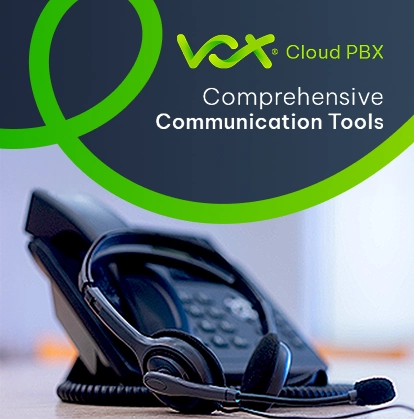Before being wooed by features and stickers, get to grips with whether the foundation will keep the house standing.
Andrew King, Head of Division: Voice and Visual Comms and Natalie van der Merwe, Head of Product: Telephony at Vox
While energy security is a hot topic around the world, South Africa is in the unenviable position of having endured power cuts every single day so far in 2023. No one needs to go into exactly what this means for the economy at large, but one thing it most certainly does is force businesses to look into the most effective ways to ensure business continuity, not least in communications – both internally and externally.
Business communications are far too big a consideration to leave to chance, and it is with this in mind that the unified communications and collaboration (UC&C) solutions are increasingly in business C-suite plans, with voice, or more specifically voice over internet protocol (VoIP) front and centre.
After all, who wouldn’t want to be protected from the legacy of copper and the unreliability of physical infrastructure such as power? And so, it is no surprise that VoIP providers, specifically, and UC&C providers more broadly, wish to position themselves uniquely in a market desperate for communications reliability.
However, it is vital for businesses to understand the fundamentals of how to measure and assess voice, and UC&C, solutions. It’s not uncommon to find checklists that speak to features as people try and figure out how and where they should be investing. These features include things such as: cloud- based, affordable, flexible and scalable. This is all good and well, but choosing the right provider or solution needs to consider things that are far more fundamental.
Look for partners not providers
As mentioned, business communication is far too important and crucial to be reduced to a transactional supplier-customer relationship. The very nature of communications is that it is ongoing, and businesses should seek out partners who are prepared to walk the long-term journey and create continuous value. This includes things such as ongoing fraud monitoring, highly specialised local R&D teams, and 24/7, 365 monitoring of the provider’s infrastructure, including all points of interconnect and long-distance backhaul between them for failover and redundancy.
It is important for customers to know that their VOIP partner’s network is certified by the respective OEM products that they offer, for example 3CX and Operator Connect. In our case, this involves rigorous testing with each partner to ensure compatibility of our network with their platforms to deliver a seamless service that is guaranteed to work. It also means the customer is guaranteed support.
Network quality, resilience and transparency are non-negotiable
It doesn’t matter which feature you stick on, what colour you make the box, or how you position a product, it means little if the network across which the VoIP traffic will travel is not of consistently high quality. It is a foundation, a non-negotiable requirement. Unless the partner owns and controls its own network it simply cannot be in control of every element of the network and ensure end-to- end redundancy.
If users are on a call – voice or video – and something goes down along any point of the infrastructure network, users must be oblivious. In other words, they should not even notice that anything occurred – be sure to include this on any checklist. What’s the alternative? It’s a bit like going to an ice cream parlour and being served milkshakes because the fridges couldn’t stay cold.
VoIP call quality is measured by means of a MOS rating (Mean Opinion Score). MOS testing for VoIP networks is defined in the ITU-T PESQ P.862 standard. A MOS rating measures call quality on a 1-5 exponential rating, with 0 being unintelligible voice and 5 being excellent voice quality. Vox’s MOS score is an impressive 4.3, for example. When shopping around, request this information. This is where transparency goes a long way towards building trust, which in turn, is a key component of building partnerships as opposed to transactional relationships.
Taking the transparency and quality theme further, businesses must ask about codec practices. The maximum MOS rating for a G.711 or G.722 VoIP call is 4.4/5. The G.722 and G.711 codec – used to convert speech to digital packets for transmission over Internet Protocol [IP] networks and decode the packets into intelligible speech on the other end of the call – are uncompressed codecs that provide the best possible call quality.
Vox’s VoIP network by default offers the G.722, G.711 a-law and the lesser quality G.729 codecs. Make sure to ask this question of all providers, because if a business uses an operator that runs on a G.729 codec only – a highly compressed codec- then the voice quality is going to suffer from the outset. You will also typically find that the provider is compressing their voice packets to utilise less bandwidth on their network. And so when businesses ask the right questions and work through their checklist, they must understand that a network that hasn’t been designed with enough bandwidth or capacity to deliver a reliable, uncongested service to multiple customers, necessitates using compressed codec.
Something everyone reading this will have experienced at some point in their lives is latency, jitter and packet loss. Latency is the delay between when data is sent and received and is mainly caused by too little bandwidth or too many hops between networks. Jitter, simply, is the variation in latency and packet loss is the dropping of data packets when network congestion occurs.
Why does this matter? Latency causes noticeable delays and lags in a conversation, jitter results in uneven speech and delays and packet loss is where bits of speech become garbled or disappear. Hardly the kind of thing a business would want when communicating with customers or when teams are collaborating on important tasks. As a business, it is your right to know what a provider has done to mitigate these problems, such as: does it own and manage its own tier-one network?
Latency, jitter and packet loss will impact the MOS rating of a communication provider’s network. Ask them for proof of their average MOS score and which codec they run their voice network on as standard before you commit your money and your customer’s perception of your business to any contract term.
Lean on the global giants while looking for local innovation
We all experienced how Microsoft Teams evolved during the pandemic. The innovation curve of global giants with large R&D teams is a sight to behold. Whether it is a platform like 3CX or Microsoft Operator Connect, these tried and trusted global businesses are at the bleeding edge of communications technology, while providing the peace of mind that they will still be here tomorrow, next week, and next decade. Look for solutions that don’t rely on small local teams for their very existence, but are provided by partners who instead deploy their dedicated, certified local teams to innovate and advise on how to leverage these global solutions best in the uniquely South African context. That’s the golden ticket to a win-win scenario.
In summary, before looking at generic terms such as fibre-powered, cloud-based, cost-effective and scalable, peer through the windows of the house, analyse the walls, and ask to see the foundations – that’s the checklist that will bring you closer to choosing a UC&C partner that can deliver the best voice and communication service for your specific business needs.












